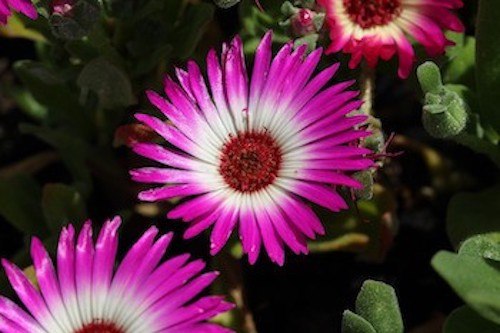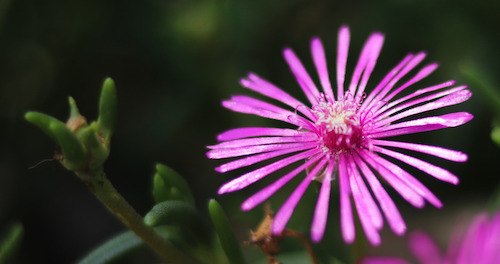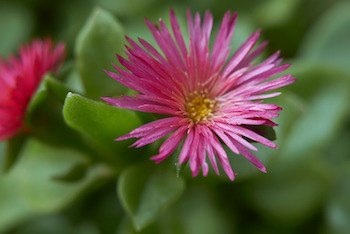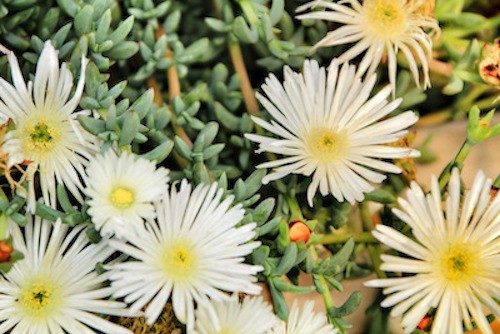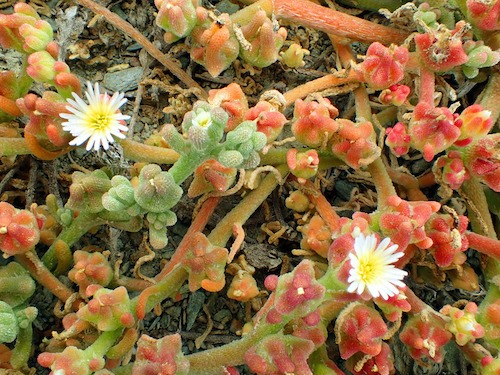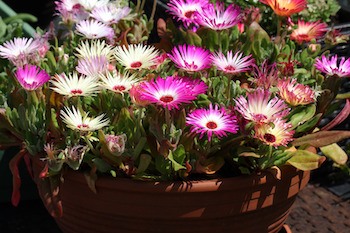The Mesembryanthemum is a beautiful small plant that looks good in your garden or inside your home. It’s no wonder this tiny flowering succulent is so beloved by gardeners all over the UK.
You will like the plethora of colours and shapes, complemented with fleshy leaves. If you’re a novice gardener, you’ll love how low maintenance they are. You can choose a variety of containers and you don’t have to water them a lot. If you want to know more about that, read on!
Table of Contents
What’s a Mesembryanthemum?
Mesembryanthemum plants are certainly a mouth full. Their ancestors come from exotic southern Africa, which explains why they don’t need a lot of water.
Mesembryanthemums are a succulent species, which means their leaves are specialized in retaining water. Much like a cactus, they have fleshy leaves.
You’ll also find the Mesembryanthemum under the name of the ice plant. This nickname stems from the leaves as well, which seem to glow and shine. In the right light, Mesembryanthemum leaves are as sparkly as ice.
Mesembryanthemum flowers are also beautiful, with the same shape as daisies. Mesembryanthemums bloom at the beginning of the warm season, mostly during spring and summer. You can pick the colours that will look best in your garden, interspersed with other species and colours. You can choose an intense red, a delicate white or pink, and summery yellow plus other nuances.
Here’s what you can expect with your Mesembryanthemum:
- The flowers can develop in clusters, but they can also be single.
- The flowers are long-lasting.
- The Mesembryanthemum height varies between 10 and 30 centimetres.
- Some Mesembryanthemums grow horizontally.
Tips and tricks:
- Use the shorter fellows for your groundcover and the taller ones along your garden’s edges.
- If you have a rock garden, choose a taller variety of Mesembryanthemum flowers.
Mesembryanthemum Species
Genus Mesembryanthemum may contain a lot of species, it’s basically impossible to distinguish the true species – unless you work in a lab.
A quick online research gets you a lot of synonyms and aliases, plus a lot of similar-looking plants. Moreover, genetic sequencing showed that even what we thought was true Mesembryanthemums turned out to be included in other genera.
We’re talking about the Heartleaf Ice Plant, former Mesembryanthemum cordifolium, which is now Aptenia cordifolia. Look at the picture. Almost no one could possibly tell it’s not a true Mesembryanthemum.
However, we can ensure at least the following two species can be included in this genus:
- Ice Plant (Mesembryanthemum crystallinum) is best for eating, making soap, and bio-remediation. Also for admiring in your garden, if you’re a fan of those big enlarged epidermal cells that look like bubbles.
- Slender Leaf Ice Plant (Mesembryanthemum nodiflorum) is best for edging your garden because it reaches up to 20 cm. Its white or pale-yellow flowers complement any garden décor.
Growing Instructions
The half-hardy annual Mesembryanthemum is an easy plant to grow. It’s draught-resistant and it prefers true sun. The plants need a distance of about 15 to 30 centimetres to grow beautifully.
You can grow them on beds and borders, inside in containers, or even in hanging baskets. If you choose to place them outside, the bees in your garden will be in seventh heaven. The only problem is they can get a little invasive.
With that in mind, let’s see some tips on how to grow your Mesembryanthemum.
Remember that you can only use Mesembryanthemum seeds for the job. It’s best to start after the last frost of March up until May for optimum results.
-
- Mix sand with compost and perlite in equal proportions
- Sift the resulting mixture to make sure there isn’t any debris.
- Fill your sowing trays with this mixture. Make sure the trays are well levelled and watered.
- Sow your seeds.
- Cover them with a thin layer of your mixture, then water again.
- Put the containers in a warm area exposed to natural sunlight for a minimum of ten hours.
- Sprinkle the containers with water when you see them completely dry.
- You will notice the first sprouts appearing in about two to three weeks.
- Take the new seedlings into the full-sun when they’ve grown to about 2.5 centimetres.
- Water the plants in their new spot until they’re completely developed.
When your Mesembryanthemums reach the size you’re most happy with, prune them immediately. Mesembryanthemum is invasive, so they’ll grow without stopping if you don’t do something about it.
Pro tips:
- Young plants need more water to make sure they develop completely, so don’t skimp on watering them.
- If you want your Mesembryanthemum to grow inside before moving it outside, start the sowing process three months faster.
- Make sure your room is dark and its temperature is about 21ᵒ for the germination stage.
- Place smaller Mesembryanthemums at a distance of about 11-15 cm between each other. Taller Mesembryanthemums should be 20-30 cm apart.
Plant Care
Remember the south-African lineage of Mesembryanthemums? That’s important because it tells you the Mesembryanthemums need warm weather to thrive.
That doesn’t mean you have to up your room temperature to 30ᵒ or move to the tropics. However, ensure you can protect your Mesembryanthemum friends from frost. Freezing winters destroy the Mesembryanthemums, so you need to move them inside.
The fact that Mesembryanthemums have fleshy leaves that retain water is also important. It tells you these plants don’t need to be watered frequently. In fact, overwatering can kill them. Another consequence is they thrive in sandy soil that allows good water drainage.
If your garden soil is bad for most flowers, it probably means it’s perfect for Mesembryanthemums. These flowers grow extremely beautiful in dry and poor soils. They even deal well with salty soils. If you want them to grow bigger and more appealing – if that’s even possible – consider a liquid fertilizer after their last bloom.
How do you water Mesembryanthemums? To make sure they don’t get too much water, soak the soil around them. Don’t give them more to drink until the soil is moisture-free.
What about growing them inside?
Caring for your Mesembryanthemum inside doesn’t need a lot of extra effort, but ensure that:
- You place your Mesembryanthemum in a container with good drainage.
- Place your container near a window that offers enough natural sunlight.
In Conclusion
Mesembryanthemums are beautiful plants because they look delicate, but they’re strong and feisty. These plants are best suited for a warm, sunny garden, with dry soil. They’ll look well in a rock garden if you’re a beginner, but also a more elaborate flower garden.
Remember to keep them in full sunlight and to avoid watering them. Place the plants far enough from each other and prune them frequently. And, if your Mesembryanthemum turns out to be something else, don’t be discouraged. It still makes your garden shine whenever it’s in full bloom.

